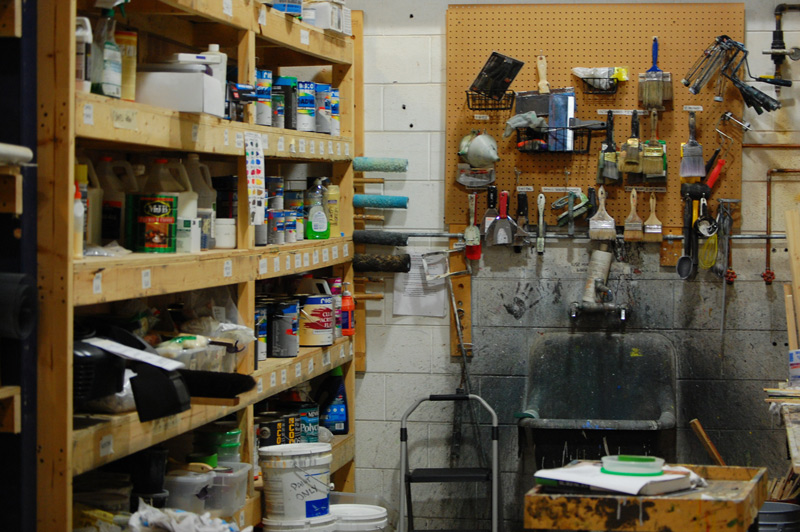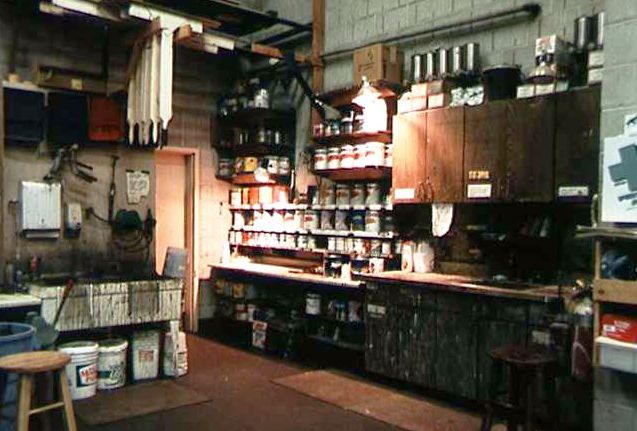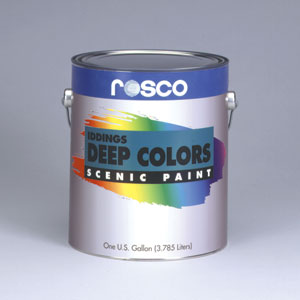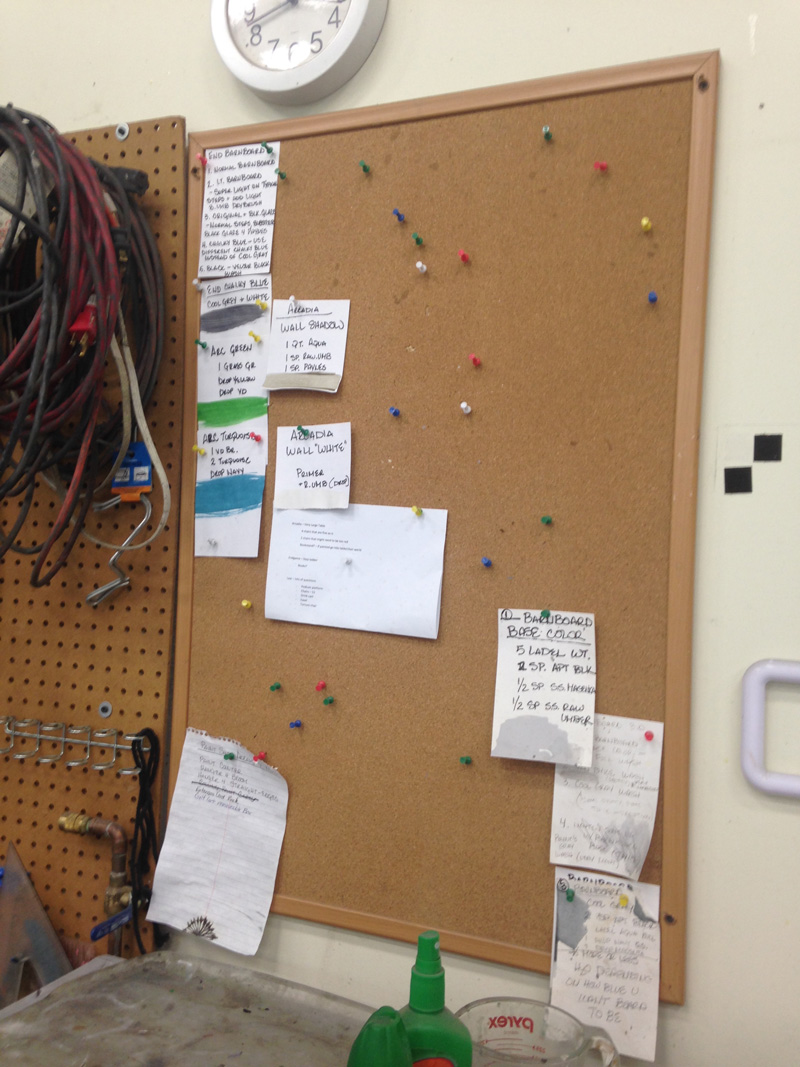The Undergraduate Paint Shop – Strategies from a Scenic Painting Professional
by Tiffany Fier - North Dakota State University
This article is a resource for the Shop Manager/TD/Multi-Tech field professor who is also in charge of painting scenery.
Setting Up Your Paint Shop Area
The best way to get your paint area/paint shop up to speed is to start by taking an assessment of your shop’s situation. Is your paint area in the best location it can be? It needs to be near a sink if it isn't already. Do you have a neat and orderly paint mixing table? Have you let the paint area go and has it become a mess? This is the time to start fresh. A clean paint area is a functioning paint area.
 If you have a back-log of old, watery paint, get rid of it. Toss in a bunch of saw dust pulled from your saw dust trap and mix it in to dry it out. This is a standard practice with left over paint. Do not throw wet paint in the dumpster. Another option is calling up your campus Haz-Mat team and see if they are willing to dispose it for you. The important thing is to get rid of the clutter.
If you have a back-log of old, watery paint, get rid of it. Toss in a bunch of saw dust pulled from your saw dust trap and mix it in to dry it out. This is a standard practice with left over paint. Do not throw wet paint in the dumpster. Another option is calling up your campus Haz-Mat team and see if they are willing to dispose it for you. The important thing is to get rid of the clutter. 
Paint brushes that are beyond fixing do not need to stay in your inventory. Toss them. If you have some brushes that are a little stiff or crusty, soak them in Murphy’s Oil Soap over the weekend and give them a good cleaning on Monday and they will be good as new. In a pinch try some hot vinegar. A good stiff wire brush will help get the crust out. Make sure you are only using Murphy’s Oil Soap to clean your brushes. Dish detergent is too harsh and no soap at all is even worse.
Start dating all new purchased and mixed paint to know how long they have been sitting on the shelf. All paint containers need to be labeled. It’s an OSHA standard practice. It’s a waste of precious time if you have to sort out over and over again what is contained within an unlabeled container of paint. If you don’t know what it is, get rid of it! Label it by paint color, any additives, and what production it was created. Use masking tape for labels.
Budgeting
If you haven’t already, create a budget subcategory for paint in your set budgets. You should give yourself a minimum of $200 per production, if possible. Similar to most art/theatrical supplies, cheap equals poor quality. Wal-Mart paint is poor quality paint and will give you lack-luster results. Using white house paint to prime your surfaces instead of actual primer, will give you poor results. Investing in quality products when possible is your best option and is a better teaching tool that cheap paint. Good paint is an educational investment.
Safety
Painting doesn't immediately appear to be a place where safety is paramount. Paints are full of chemicals and it’s important to treat it with the same respect as any other potentially harmful chemical. Make it a practice to only use water-based paints and never oil-based unless you have a local exhaust ventilation system, nitrile gloves, and the correct respirators. Oil-based paints take an extra amount of safety equipment to use correctly. If you don’t know what that means, check out the online SDS sheet for the product and use the recommended safety procedures. This caution must also be used with spray paint (really, really bad for you), polyurethane, and most adhesives. You must use chemical resistant gloves not latex-glove. Latex only protects against mild irritants and blood-borne pathogens.
Recommended book: The Health and Safety Guide for Film, TV, and Theatre by Monona Rossol
Products
The typical scenic paints used in the undergraduate theatre are: Rosco Off-Broadway, Iddings Deep Colors, or Artist’s Choice. These paints  were manufactured for painting scenery. Normal house paint is not. As soon as you add any sort of water to house paint, you are using it in a way it’s not meant to be used.
were manufactured for painting scenery. Normal house paint is not. As soon as you add any sort of water to house paint, you are using it in a way it’s not meant to be used.
Prime your set surfaces using primer not white house paint. Why? If you use watery paint over white house paint the white house paint will begin to reactivate and lift. This is due to the fact you’re not using the paint the way it was made to be used.
If you can’t afford a good set of brushes then use chip brushes NOT cheap black nylon brushes. Purdy brand brushes are my personal recommendation for lay-in brushes but it’s also good to have a cheaper set for priming and basing. Test out different brushes. Feel the bristles in your hand. If the bristles feel cheap and stiff, that means they will not serve you well when painting.
Additional texturing tools like sea sponges, wood grainers, and Hudson sprayers are a must. Knowing how to properly use these products is equally important. If you don’t know how to use them, find someone who does. And, finally, get to know a local paint shop. They may give you discounts or be there for helpful advice.
A Clean Shop is a Happy Shop
A messy shop or paint area will remain that way unless you set a standard for yourself and other students to follow. A certain level of messiness comes with any shop. Find a student to be in charge of keeping things tidy. Doing so takes additional burden over your already over-worked self.  Use recipe cards for each paint color mixed for each production to help you stay organized and so you can mix more of that color if you run out. Having a cork board to post your current recipes is a great idea.
Use recipe cards for each paint color mixed for each production to help you stay organized and so you can mix more of that color if you run out. Having a cork board to post your current recipes is a great idea.
Use cotton rags instead of disposable rags. At the end of each use, cotton rags can be washed out and hung up to dry.
It’s important for the students to have the same respect for the paint area as you. Make cleanliness expectations perfectly clear. This will help keep unforeseen messes from popping up when you’re not paying attention. Tell students to clean out paint containers like they would do their own dishes. Have scrub brushes and scouring pads available to help clean out the containers.
Avoid using old food containers unless they are well-labeled. This is an OSHA standard. Avoid pouring old paint down the sink unless you have a paint trap. Have a slop bucket for old paint, it can be used for back painting scenery. If you have no further use for the paint, dump sawdust or kitty litter into it and let it completely dry out before tossing it into a dumpster. [ ]
Tiffany Fier is an Assistant Professor of Set Design at North Dakota State University.
tiffany.fier@ndsu.edu
